G. Henle Musikverlag Piano Music
- p.1 (Al - Ba)
- p.2 (Ba - Ba)
- p.3 (Ba - Be)
- p.4 (Be - Br)
- p.5 (Br - Ch)
- p.6 (Ch - De)
- p.7 (De - Ha)
- p.8 (Ha - Li)
- p.9 (Li - Mo)
- p.10 (Mo - Sa)
- p.11 (Sa - Sc)
- p.12 (Sc - Sc)
- p.13 (Sc - We)
- Next >
-
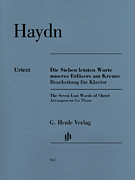
-
Haydn, Franz Joseph
Seven Last Words of Christ, The (Scheideler/Schilde)
Baroque. Written for orchestra in 1786, Haydn also made a version of The Seven Last Words of Christ for string quartet and later adapted the work as an oratorio. Although he did not write it, Haydn praised the keyboard arrangement, now available in this Urtext edition.
Category: Piano Solos
Item: 083893
Grade:
Price: $29.95
Availability: Ships in 6 to 9 Days - View Shopping Cart
-
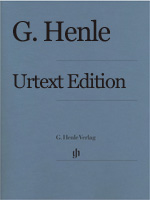
-
Haydn, Franz Joseph
Sonata in C, Hob.XVI:35
G. Henle URTEXT edition
Category: Piano Solos
Item: 013820
Grade:
Price: $8.95
Availability: Ships in 6 to 9 Days - View Shopping Cart
-
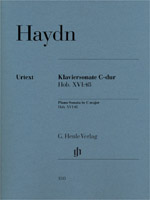
-
Haydn, Franz Joseph
Sonata in C, Hob.XVI:48 (Feder/Schloen/Anderszewski)
Classical. This Haydn sonata has previously not been available in the Henle catalogue as an individual Urtext edition. Nevertheless, it numbers among Haydn's famous piano works. It was written in 1789 (thus making it one of the "late sonatas") for the Leipzig publisher Christoph Gottlob Breitkopf. Its two-movement structure fathoms the entire spectrum of Haydn's musical language: from the brooding-improvisational first movement to the sparkling, humorous Finale. Haydn exploits here the full range...
Read More
Category: Piano Solos
Item: 132128
Grade: Advanced
Price: $11.95
Availability: Usually Ships in 24 Hours - View Shopping Cart
-
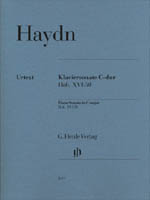
-
Haydn, Franz Joseph
Sonata in C, Hob.XVI:50 (Feder)
Category: Piano Solos
Item: 137811
Grade: Grade 6 - Advanced
Price: $11.95
Availability: Usually Ships in 24 Hours - View Shopping Cart
-

-
Haydn, Franz Joseph
Sonata in D, Hob.XVI:37
G. Henle URTEXT edition (sample page)
(sample page)
Category: Piano Solos
Item: 009547
Grade:
Price: $8.95
Availability: Ships in 6 to 9 Days - View Shopping Cart
-
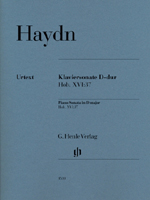
-
Haydn, Franz Joseph
Sonata in D, Hob.XVI:37 (Feder)
Category: Piano Solos
Item: 133268
Grade:
Price: $9.95
Availability: Usually Ships in 24 Hours - View Shopping Cart
-

-
Haydn, Franz Joseph
Sonata in Eb, Hob.XVI:52 (Feder/Theopold)
Category: Piano Solos
Item: 112167
Grade:
Price: $10.95
Availability: Ships in 10 to 15 Days - View Shopping Cart
-
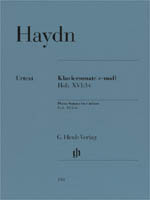
-
Haydn, Franz Joseph
Sonata in Em, Hob.XVI:34 (Feder)
Only a few of Haydn's piano sonatas are in the minor mode, and they are all sombre and defiant in tone. This famous sonata in e minor opens with an impatient, throbbing motif in what is surely one of the most passionate movements by this Viennese master.The middle movement in G major, by contrast, transports us into a different world that is flooded with light. The finale sets off in a restless manner, and its alternation of major and minor provides a cheerfully ironic close to the work. You can ...
Read More
Category: Piano Solos
Item: 134644
Grade:
Price: $9.95
Availability: Ships in 10 to 15 Days - View Shopping Cart
-

-
Haydn, Franz Joseph
Sonata in Em, Hob.XVI:34 (Feder/Theopold)
Classical. With this E minor piano sonata, Classical-era composer Haydn created a work that displays positively romantic traits. Agitation and excitement are expressed in the main ideas of the first movement, while contrasting seriousness and cheerfulness come into sharp relief in the finale. Of Haydn's sixty-or-so piano sonatas, the E minor Sonata numbers are among those of moderate difficulty. Our editor, Georg Feder, is considered one of the most important Haydn researchers of this time. Conse...
Read More
Category: Piano Solos
Item: 006530
Grade:
Price: $8.95
Availability: Ships in 6 to 9 Days - View Shopping Cart
-

-
Haydn, Franz Joseph
Sonata in F, Hob.XVI:23 (Feder/Badura-Skoda)
Category: Piano Solos
Item: 140683
Grade: Advanced
Price: $12.95
Availability: Usually Ships in 24 Hours - View Shopping Cart
-
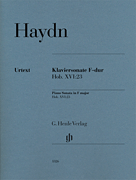
-
Haydn, Franz Joseph
Sonata in F, Hob.XVI:23 (Feder)
Category: Piano Solos
Item: 112529
Grade:
Price: $9.95
Availability: Ships in 10 to 15 Days - View Shopping Cart
-

-
Haydn, Franz Joseph
Sonata in G, Hob.XVI:40
G. Henle URTEXT edition.
Category: Piano Solos
Item: 013874
Grade:
Price: $11.95
Availability: Ships in 6 to 9 Days - View Shopping Cart
-
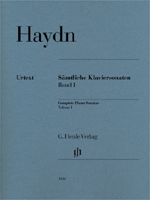
-
Haydn, Franz Joseph
Sonatas Complete, v.1 (Feder/Raab/Schloen)
Baroque. 55 internationally celebrated pianists were invited to adopt one Haydn piano sonata each and provide it with their personal fingerings - a "who's who" on the contemporary piano scene. G. Henle Publishers now presents this classic, revised and with a new look, to all pianists in the certainty that Haydn's sonatas will further cement their place in the world of music. Volume I contains Haydn's early sonatas, very much still born of the spirit of the early Classical period: catchy music, fu...
Read More
Category: Piano Composer Folios
Item: 132486
Grade: Advanced
Price: $45.95
Availability: Usually Ships in 24 Hours - View Shopping Cart
-
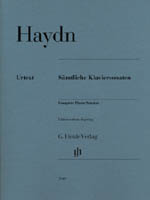
-
Haydn, Franz Joseph
Sonatas Complete, v.1 [without fingering] (Feder/Raab/Schloen)
Henle Urtext Edition in 3 volumes: 132758, 132759, 132760. The revision of the three-volume edition of Haydn's piano sonatas also appears in a version without fingerings. Whoever wishes to study the Classical sonata canon in "pure" Urtext, free from added fingering suggestions, will now also find these in the Henle catalogue. Volume I contains Haydn's early sonatas, very much still born of the spirit of the early Classical period: catchy music, fun to play, often at a moderate level of difficult...
Read More
Category: Piano Composer Folios
Item: 132758
Grade:
Price: $49.95
Availability: Usually Ships in 24 Hours - View Shopping Cart
-
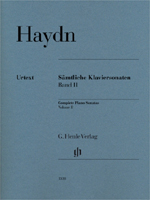
-
Haydn, Franz Joseph
Sonatas Complete, v.2 (Feder/Raab/Schloen)
Baroque. 55 internationally celebrated pianists were invited to adopt one Haydn piano sonata each and provide it with their personal fingerings - a "who's who" on the contemporary piano scene. G. Henle Publishers now presents this classic, revised and with a new look, to all pianists in the certainty that Haydn's sonatas will further cement their place in the world of music. Volume II contains three sets of six sonatas, each more famous than the last and all replete with delightful thematic ideas...
Read More
Category: Piano Composer Folios
Item: 132487
Grade: Advanced
Price: $49.95
Availability: Usually Ships in 24 Hours - View Shopping Cart
-

-
Haydn, Franz Joseph
Sonatas Complete, v.2 [without fingering] (Feder/Schloen)
Henle Urtext Edition in 3 volumes: 132758, 132759, 132760. The revision of the three-volume edition of Haydn's piano sonatas also appears in a version without fingerings. Whoever wishes to study the Classical sonata canon in "pure" Urtext, free from added fingering suggestions, will now also find these in the Henle catalogue. Volume I contains Haydn's early sonatas, very much still born of the spirit of the early Classical period: catchy music, fun to play, often at a moderate level of difficult...
Read More
Category: Piano Composer Folios
Item: 132759
Grade:
Price: $49.95
Availability: Usually Ships in 24 Hours - View Shopping Cart
-
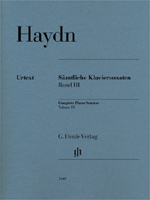
-
Haydn, Franz Joseph
Sonatas Complete, v.3 (Feder/Raab/Schloen)
Baroque. 55 internationally celebrated pianists were invited to adopt one Haydn piano sonata each and provide it with their personal fingerings - a "who's who" on the contemporary piano scene. G. Henle Publishers now presents this classic, revised and with a new look, to all pianists in the certainty that Haydn's sonatas will further cement their place in the world of music. Volume III offers the crowning achievement of Haydn's sonata-writing with these late works, including famous works such as ...
Read More
Category: Piano Composer Folios
Item: 132488
Grade: Advanced
Price: $45.95
Availability: Ships in 10 to 15 Days - View Shopping Cart
-

-
Haydn, Franz Joseph
Sonatas Complete, v.3 [without fingering] (Feder/Schloen)
Henle Urtext Edition in 3 volumes: 132758, 132759, 132760. The revision of the three-volume edition of Haydn's piano sonatas also appears in a version without fingerings. Whoever wishes to study the Classical sonata canon in "pure" Urtext, free from added fingering suggestions, will now also find these in the Henle catalogue. Volume I contains Haydn's early sonatas, very much still born of the spirit of the early Classical period: catchy music, fun to play, often at a moderate level of difficult...
Read More
Category: Piano Composer Folios
Item: 132760
Grade:
Price: $45.95
Availability: Ships in 10 to 15 Days - View Shopping Cart
-

-
Haydn, Franz Joseph
Sonate in Eb, Hob.XVI:49
G. Henle URTEXT edition.
Category: Piano Solos
Item: 009548
Grade:
Price: $11.95
Availability: Ships in 6 to 9 Days - View Shopping Cart
-
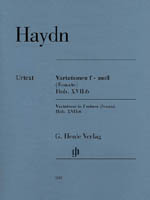
-
Haydn, Franz Joseph
Variations in Fm (Sonata), Hob.XVII:6 (Gerlach/Schornsheim)
G. Henle Urtext edition. Edited by Sonja Gerlach, fingering by Christine Schornsheim. Haydn's last piano work is also considered to be his most famous single work for this instrument. The minor theme is filled with emotional depth: "a melancholy andante in f minor, with variations, as only a genius can do them, that almost sounds like a free fantasia" (thus described in a review of the time). The form is also demanding: not merely one theme but two - one in a major key, the other in a minor one -...
Read More
Category: Piano Solos
Item: 075864
Grade:
Price: $10.95
Availability: Ships in 6 to 9 Days - View Shopping Cart
-

-
Haydn, Franz Joseph
Variations on Gott Erhalte
G. Henle URTEXT edition.
Category: Piano Solos
Item: 027247
Grade:
Price: $7.95
Availability: Ships in 6 to 9 Days - View Shopping Cart
-

-
Haydn, Franz Joseph
Variations on the Hymn Gott Erhalte (Gerlach/Schornsheim)
G. Henle urtext edition. Setting of the Austrian national anthem for solo piano as conceived by the composer. Edited by Sonja Gerlach. Fingering by Christine Schornsheim.
Category: Piano Solos
Item: 078119
Grade:
Price: $9.95
Availability: Ships in 6 to 9 Days - View Shopping Cart
-

-
Heller, Stephen
Selected Works - Character Pieces (Kerstein)
G. Henle URTEXT edition.
Category: Piano Composer Folios
Item: 009549
Grade:
Price: $21.95
Availability: Ships in 6 to 9 Days - View Shopping Cart
-
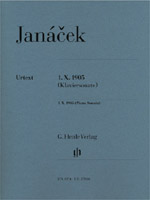
-
Janacek, Leos
1.X. 1905 (Zahradka)
The composition "1.X.1905," generally referred to as a "sonata," stems from the autumn of 1905, the peak of the riots between the Czech- and German-speaking populations in Jan cek's hometown Brno. Reacting to the violent death of a Czech worker, Jan cek wrote a three-part composition for piano originally bearing the title "From the Street, on October 1, 1905." Dissatisfied with the work, however, Jan cek is said to have first burned the third movement in his fireplace and then thrown the remainin...
Read More
Category: Piano Solos
Item: 128558
Grade:
Price: $15.95
Availability: Ships in 10 to 15 Days - View Shopping Cart
-
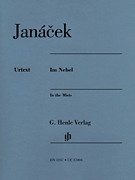
-
Janacek, Leos
Im Nebel (In the Mists) (Zahradka)
Piano music occupies a small, but nevertheless musically important place in Janacek's oeuvre. Our edition of "In the Mists" by the seasoned Janacek editor Jirˇ Zahradka is an impressive example of this. The small cycle was composed in 1912 and first published the following year. But as was so often the case, Janacek was prompted to revise it. Following the first performance of the work in Prague by the pianist Stepan Vaclav in December 1922, the composer and interpreter jointly undertook a revisi...
Read More
Category: Piano Solos
Item: 113855
Grade:
Price: $15.95
Availability: Ships in 10 to 15 Days - View Shopping Cart
-

-
Janacek, Leos
On an Overgrown Path [Auf Verwachsenem Pfade] (Zahradka/Vogt)
Janacek's poetic cycle "On an overgrown path" is surely among his most popular piano works. Its evocative musical language will drawevery hearer under its spell. Listeners will not be able to discern that the pieces had a very complex and protracted genesis, with some originally intended for harmonium. With exemplary clarity, the accompanying texts in Henle's Urtext edition shed light on the complicated source situation. In addition, an appendix to the musical text contains those pieces that Jana...
Read More
Category: Piano Solos
Item: 135198
Grade: Advanced
Price: $23.95
Availability: Ships in 10 to 15 Days - View Shopping Cart
-
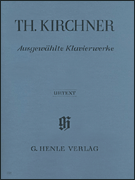
-
Kirchner
Selected Works (Hofmann/Herttrich/Smith)
G. Henle URTEXT edition.
Category: Piano Composer Folios
Item: 009808
Grade:
Price: $33.95
Availability: Ships in 6 to 9 Days - View Shopping Cart
-
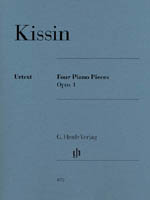
-
Kissin, Evgeny
Piano Pieces (4), op 1
Category: Piano Composer Folios
Item: 127183
Grade:
Price: $18.95
Availability: Ships in 10 to 15 Days - View Shopping Cart
-
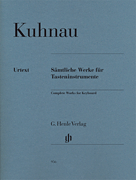
-
Kuhnau, Johann
Complete Works for Keyboard (Mullemann)
All of Kuhnau's works published together in one volume for the first time.
Category: Piano Composer Folios
Item: 103771
Grade:
Price: $79.95
Availability: Ships in 6 to 9 Days - View Shopping Cart
-

-
Liszt, Franz
Annees de Pelerinage, v.3 - Troisieme Annee (Jost)
The three volumes of the "Annees de pelerinage" (Years of Pilgrimage) are a core part of Liszt's pianistic output. While the first two collections comprise travel impressions from Switzerland and Italy in the 1830s, this final one, published only after along interval in 1883, reflects a spiritual journey. It is the expression of the changed circumstances of the composer, who had taken minor holy orders in Rome in 1865 and henceforth called himself the "Abbe Liszt." Several newly-discovered or ne...
Read More
Category: Piano Solos
Item: 134768
Grade: Advanced
Price: $27.95
Availability: Ships in 10 to 15 Days - View Shopping Cart
-
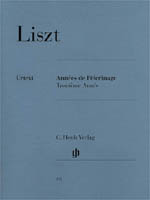
-
Liszt, Franz
Annees de Pelerinage, v.3 - Troisieme Annee (Herttrich)
G. Henle URTEXT edition. In 1883 the third volume of Annees de Pelerinage was published. Whereas the pieces in Volumes I and II were recollections of early travels in Switzerland and Italy, the new works, composed between 1867 and 1877, were more of a religious pilgrimage. Some parts already reflect Liszt's austere later compositional style. With the visionary Jeux d'eaux … la Villa d'Este, on the other hand, he almost enters the world of Impressionist sounds (it inspired Ravel to write his Jeux ...
Read More
Category: Piano Solos
Item: 013943
Grade:
Price: $18.95
Availability: Ships in 6 to 9 Days - View Shopping Cart
-
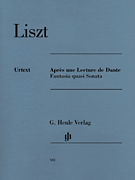
-
Liszt, Franz
Apres une Lecture de Dante - Fantasia Quasi Sonata (Herttrich/Theopold)
Romantic. Often referred to as the "Dante Sonata," this single-movement sonata is based on the Canto "Inferno" in Dante's poem, which depicts the soul's descent into hell. Now available as a single Urtext edition.
Category: Piano Solos
Item: 083892
Grade:
Price: $18.95
Availability: Ships in 6 to 9 Days - View Shopping Cart
-
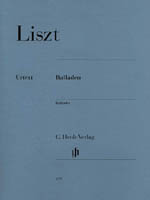
-
Liszt, Franz
Ballades (2) (Mueller)
G. Henle URTEXT edition. Liszt wrote his two Ballades in 1845-49 and 1853 during a time of personal turmoil. The successful virtuoso increasingly saw himself as a composer who strove after formal clarity, as shown by the B minor sonata that was also composed in 1853. When Liszt began work on the first Ballade, he had just separated from his mistress of many years, Marie Comtesse d'Agoult. He called the first sketches for the work DerniŠres Illusions. A better-known work is the second Ballade in B...
Read More
Category: Piano Composer Folios
Item: 029281
Grade:
Price: $24.95
Availability: Ships in 6 to 9 Days - View Shopping Cart
-

-
Liszt, Franz
Benediction du Dieu Dans la Solitude (Heinemann)
Category: Piano Solos
Item: 083267
Grade:
Price: $14.95
Availability: Ships in 6 to 9 Days - View Shopping Cart
-

-
Liszt, Franz
Concert Etudes (2)
G. Henle URTEXT edition.
Category: Piano Composer Folios
Item: 016768
Grade:
Price: $18.95
Availability: Ships in 6 to 9 Days - View Shopping Cart
-
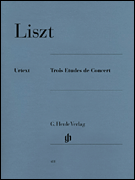
-
Liszt, Franz
Concert Etudes (3)
G. Henle URTEXT edition. Contents:
• Il lamento
• La leggierezza
• Un sospiro
Category: Piano Composer Folios
Item: 023207
Grade:
Price: $17.95
Availability: Ships in 6 to 9 Days - View Shopping Cart
-
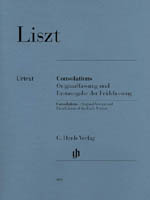
-
Liszt, Franz
Consolations (Eckhardt)
G. Henle URTEXT edition. These six little piano pieces are among Liszt's best-known works are are comparatively easy to play - a rarity among the composer's often eccentric and virtuosic works. In 1844 Liszt had already begun work on the cycle that was only published in 1850. Although he had the pieces engraved, this version was never actually printed. He replaced no. 3, a precursor to the first Hungarian Rhapsody, with a piece in the style of a nocturne by Chopin (it can occasionally be heard as...
Read More
Category: Piano Composer Folios
Item: 015717
Grade:
Price: $19.95
Availability: Ships in 6 to 9 Days - View Shopping Cart
-

-
Liszt, Franz
Harmonies Poetiques & Religieuses
G. Henle URTEXT edition.
Category: Piano Solos
Item: 033585
Grade:
Price: $36.95
Availability: Ships in 6 to 9 Days - View Shopping Cart
-

-
Liszt, Franz
Hungarian Rhapsody No. 1 (Jost/Eckhardt)
Liszt understood a "rhapsody" to signify the highest degree of musical freedom: a constant process of transformation and variation of themes and motifs, all bound up with constant shifts of emotion. According to one of its early reviewers, this first of Liszt's 19 Hungarian Rhapsodies is a prime example of "the art of thematic working such as no previous master has practised more fantastically, more expressively or more inventively." Despite this, it was somewhat overshadowed by the greater popul...
Read More
Category: Piano Solos
Item: 135204
Grade: Advanced
Price: $13.95
Availability: Usually Ships in 24 Hours - View Shopping Cart
-

-
Liszt, Franz
Hungarian Rhapsody No. 2 (Herttrich, et al)
Edited by Ernst Herttrich. Preface by Maria Eckhardt. Fingering by Andreas Groethuysen.
Category: Piano Solos
Item: 058761
Grade:
Price: $16.95
Availability: Ships in 6 to 9 Days - View Shopping Cart
-
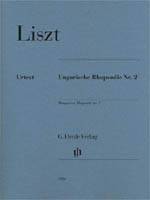
-
Liszt, Franz
Hungarian Rhapsody No. 2 (Jost)
Liszt's piano rhapsodies are in the same tradition as his transcriptions of opera or song themes, but in this case the point of departure is folk dances and songs. Liszt described no. 2 of his Hungarian Rhapsodies, published in 1851, as "truly Hungarian," and a "brilliant companion piece" to his own concert showpiece the Grand Galop chromatique. And indeed, the work, with its strong dynamic and harmonic contrasts, quickly became popular and remains among his best-loved keyboard works. The long-i...
Read More
Category: Piano Solos
Item: 134657
Grade:
Price: $17.95
Availability: Ships in 10 to 15 Days - View Shopping Cart
-

-
Liszt, Franz
Hungarian Rhapsody No. 3 (Jost)
Liszt's Hungarian Rhapsody no. 3 is the shortest of his series of 19 Rhapsodies published in 1852 and represents an extensive reworking of a Hungarian National Melody published already ten years before. A comparison of the two shows that Liszt does justice to his new title of "Rhapsody" through a substantially freer treatment of harmony, rhythm and compositional structure. Typical characteristics of this series of works - such as augmented seconds, oscillation between major and minor and seemingl...
Read More
Category: Piano Solos
Item: 140716
Grade: Advanced
Price: $13.95
Availability: Usually Ships in 24 Hours - View Shopping Cart
-

-
Liszt, Franz
Hungarian Rhapsody No. 4 (Jost)
Just like the third, the Fourth Hungarian Rhapsody, also issued in 1853, is based on a piano piece previously published as a Hungarian National Melody. In the course of his editing, Liszt intensified in most of the series the typical contrast between theslow first section and the fast second part: here a majestic courtship dance with chromatic ornamentation, there a climactic passage in staccato octaves that is reminiscent of Liszt's enormously demanding etudes and that brings this composition to...
Read More
Category: Piano Solos
Item: 140717
Grade: Advanced
Price: $14.95
Availability: Usually Ships in 24 Hours - View Shopping Cart
-

-
Liszt, Franz
Hungarian Rhapsody No. 5 (Jost)
The Fifth Hungarian Rhapsody, published in 1853, emerged from several earlier versions. The double character indicated in the sobriquet "H‚ro‹de ‚l‚giaque" is based on the two contrary themes: a "heroic" theme in minor and an "elegiac" theme in major, seasoned with characteristics of Liszt's "style hongrois" such as augmented seconds and sharp dotted rhythms. Thanks to the slow tempo, No. 5 is one of Liszt's less difficult rhapsodies and thus offers a wonderful introduction to these musical remin...
Read More
Category: Piano Solos
Item: 139845
Grade: Advanced
Price: $13.95
Availability: Usually Ships in 24 Hours - View Shopping Cart
-

-
Liszt, Franz
Hungarian Rhapsody No. 6 (Herttrich et al)
Edited by Ernst Herttrich. Preface by Maria Eckhardt. Fingering by Andreas Groethuysen.
Category: Piano Solos
Item: 059680
Grade:
Price: $12.95
Availability: Ships in 6 to 9 Days - View Shopping Cart
-

-
Liszt, Franz
Hungarian Rhapsody No. 9 - Carnival at Pest (Herttrich et al)
G. Henle URTEXT edition. Edited by Ernst Hettrich. Fingering by Andreas Groethuysen. Preface by Maria Eckhardt. Liszt's ninth Rhapsody is the "Carnival at Pest" - one of the few Hungarian Rhapsodies to which he gave a name. Once again Liszt turns to Hungarian folk melodies and fuses them with improvisatory elements. The result is a dazzling virtuosic firework display. The relaxed atmosphere of a Budapest carnival around 1840 is brought to life - indeed Liszt is said to have recorded several theme...
Read More
Category: Piano Solos
Item: 064508
Grade:
Price: $16.95
Availability: Ships in 6 to 9 Days - View Shopping Cart
-

-
Liszt, Franz
Hungarian Rhapsody No. 12 (Herttrich, et al)
G. Henle Urtext edition. Edited by Ernst Herttrich. Preface by Maria Eckhardt. Fingering by Andreas Groethuysen.
Category: Piano Solos
Item: 070105
Grade:
Price: $14.95
Availability: Ships in 6 to 9 Days - View Shopping Cart
-

-
Liszt, Franz
Hungarian Rhapsody No. 15 - Rakoczi March (Herttrich et al)
G. Henle urtext edition. Edited by Ernst Herttrich. Preface by Maria Eckhardt. Fingering by Andreas Groethuysen. The Rakoczi march is often referred to as the "Hungarian Marseillaise". The beginnings of this march song go back to around 1730. In the text, the Hungarians summon Franz II Rakoczi to free his people from the Habsburg oppression. The melody has been arranged many times, e. g. by Brahms and Berlioz, even Liszt made several arrangements of varying degrees of difficulty. He eventually di...
Read More
Category: Piano Solos
Item: 078447
Grade:
Price: $13.95
Availability: Ships in 6 to 9 Days - View Shopping Cart
-

-
Liszt, Franz
Legends (2) (Heinemann et al)
Edited by Ernst-Gunter Heinemann, Forward by Maria Eckhardt. Fingering by Jan Philip Schulze.
Category: Piano Solos
Item: 055902
Grade:
Price: $23.95
Availability: Ships in 6 to 9 Days - View Shopping Cart
-

-
Liszt, Franz
Les Jeux d'Eaux a la Villa d'Este (Herttrich/Theopold)
Category: Piano Solos
Item: 083020
Grade:
Price: $12.95
Availability: Ships in 6 to 9 Days - View Shopping Cart
- p.1 (Al - Ba)
- p.2 (Ba - Ba)
- p.3 (Ba - Be)
- p.4 (Be - Br)
- p.5 (Br - Ch)
- p.6 (Ch - De)
- p.7 (De - Ha)
- p.8 (Ha - Li)
- p.9 (Li - Mo)
- p.10 (Mo - Sa)
- p.11 (Sa - Sc)
- p.12 (Sc - Sc)
- p.13 (Sc - We)
- Next >
More Options
- Use our Custom Order Page to special order items you can't find.
- Use our Catalog Order Page to order items from a printed catalog, or if you already know our catalog number for the item(s) you're interested in.
- And as always, feel free to E-mail us with your questions!
